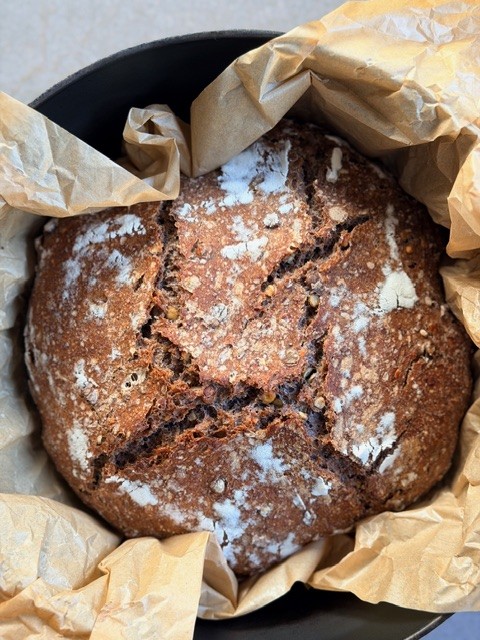I created this bread using black wheat flour but any good quality wholemeal flour will work. You can start this bread the night before as it rests for 14-18 hours.
Adding extra plant protein in your bread with lentils is not only good for you but also helps create a lovely moist and soft bread.

Mix the flours, yeast, salt, thyme and water together in a bowl until it's all combined and you can't see any dry flour. Cover the bowl and leave at room temperature for approx. 14 hours or longer, up to 18 hours if you need to, until it's risen nicely.
Dust your work surface with plenty of flour and gently tip the dough out onto your work surface. You can use a floured dough scraper or heavily floured hands here, fold the top over onto the other half, then do the same from the bottom to the top, then left to right and right to left and repeat until the bread feels much tighter and firm, then place into a floured proving basket or lined bowl, whichever you have, seam side down and leave to prove a further 2-3 hours until it's risen again,
About 30 mins before your seconding proving has finished then heat the oven to 240c/220c fan with a round cast iron pan. When you are ready to bake, remove the lid and gently tip in your dough into the tin (seam now up), cover and place in the hot oven.
TIP: An easy way to ease the dough into the pan whilst keeping as much shape as possible is to take a sheet of baking paper over a large plate, turn this over on top of the basket and then turn the plate and basket over so that the dough is then sitting on the baking paper. Carefully remove the basket and then lift the baking paper and the dough into the hot pan.
Bake your bread for 30 mins, lower the temperature by 10c and then carefully remove the pan lid, cook uncovered for a further 15 mins until you get a deep brown crispy crust.
Remove from the oven, carefully remove the bread from the pan and leave to cool on a wire rack.
Ingredients
Directions
Mix the flours, yeast, salt, thyme and water together in a bowl until it's all combined and you can't see any dry flour. Cover the bowl and leave at room temperature for approx. 14 hours or longer, up to 18 hours if you need to, until it's risen nicely.
Dust your work surface with plenty of flour and gently tip the dough out onto your work surface. You can use a floured dough scraper or heavily floured hands here, fold the top over onto the other half, then do the same from the bottom to the top, then left to right and right to left and repeat until the bread feels much tighter and firm, then place into a floured proving basket or lined bowl, whichever you have, seam side down and leave to prove a further 2-3 hours until it's risen again,
About 30 mins before your seconding proving has finished then heat the oven to 240c/220c fan with a round cast iron pan. When you are ready to bake, remove the lid and gently tip in your dough into the tin (seam now up), cover and place in the hot oven.
TIP: An easy way to ease the dough into the pan whilst keeping as much shape as possible is to take a sheet of baking paper over a large plate, turn this over on top of the basket and then turn the plate and basket over so that the dough is then sitting on the baking paper. Carefully remove the basket and then lift the baking paper and the dough into the hot pan.
Bake your bread for 30 mins, lower the temperature by 10c and then carefully remove the pan lid, cook uncovered for a further 15 mins until you get a deep brown crispy crust.
Remove from the oven, carefully remove the bread from the pan and leave to cool on a wire rack.
